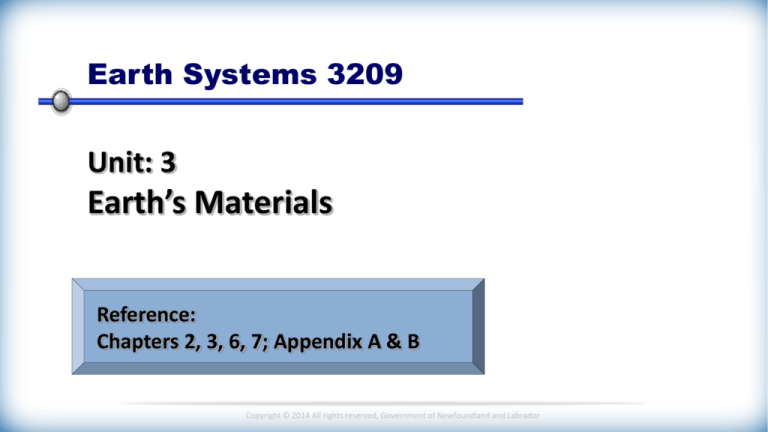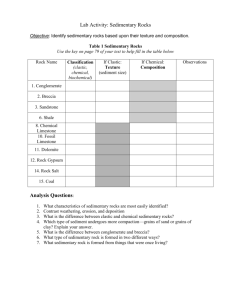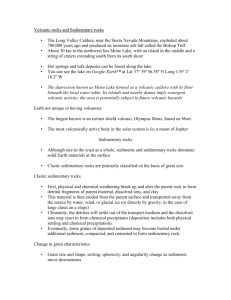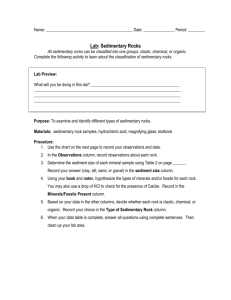
Earth Systems 3209
Unit: 3
Earth’s Materials
Reference:
Chapters 2, 3, 6, 7; Appendix A & B
Copyright © 2014 All rights reserved, Government of Newfoundland and Labrador
Unit 3:
Topic 4.3
Clastic Sedimentary Rocks
Focus on . . .
identifying the different sediments that make up
different clastic sedimentary rocks.
describing how sediment particle size, sorting and
shape can be used to classify clastic sedimentary rocks.
Copyright © 2014 All rights reserved, Government of Newfoundland and Labrador
Clastic Sedimentary Rocks – Particle Size
Consist of solid particles which results when physical weathering
breaks down rocks. The weathered products include pebbles,
sand, silt and clay.
These rocks usually form in water environments such as: rivers,
lakes, oceans, but can also form in deserts.
Geologist use particle size to distinguish between clastic
sedimentary rocks, as seen in the table below:
Particle Name
Sediment Name
Rock Name
Boulders/
Pebbles
Gravel
Sand
Sand
Sandstone
Silt
Mud
Siltstone
Mud
Shale
Clay
Round
Conglomerate
Angular
Breccia
Copyright © 2014 All rights reserved, Government of Newfoundland and Labrador
Sediment – Particle Size
This figure shows
how clastic
sediment of various
sizes will, after
compaction and
cementation, form
different types of
clastic/detrital
sedimentary rocks.
The process of
sediment turning
into rock is called
lithification.
Copyright © 2014 All rights reserved, Government of Newfoundland and Labrador
Transportation of Clastic Sediments
Current Velocity vs. Particle Size
The greater the current velocity the greater the size
of particles transported.
Therefore, as current velocity decreases, the particle
size transported decreases.
This correlates with the types of clastic sedimentary
rocks that result in a horizontal segment.
Copyright © 2014 All rights reserved, Government of Newfoundland and Labrador
Transportation of Clastic Sediments
Size
Sorting
High
Velocity
Moderate
velocity
Coarsegrained
Medium-grained
Conglomerate/Breccia
Size
Distribution
Sorting
Low
Velocity
Fine-grained
sandstone
siltstone
Copyright © 2014 All rights reserved, Government of Newfoundland and Labrador
shale
Transportation of Clastic Sediments
Sorting
Degree of similarity in particle size.
Clastic sedimentary rocks can be well-sorted
or poorly-sorted; however, sorting does not
apply to chemical sedimentary rocks.
Very poorly-sorted
moderately sorted
Very well-sorted
Copyright © 2014 All rights reserved, Government of Newfoundland and Labrador
Another example:
Transportation of Clastic Sediments
Poorly-sorted
Well-sorted
Copyright © 2014 All rights reserved, Government of Newfoundland and Labrador
Transportation of Clastic Sediments
Shape
Degree of roundness
angular
intermediate
rounded
Copyright © 2014 All rights reserved, Government of Newfoundland and Labrador
Clastic Sedimentary Rocks – Particle Shape
Particle shape is the distinguishing factor when
distinguishing between conglomerate and breccia.
Both contain similar sized particles, ex. pebbles/gravel.
Particle shape is determined by the degree of
transportation.
Conglomerate consists of rounded particles and breccia
consists of angular particles.
Rounded versus angular is determined by distance of
transportation from the source of weathering.
Copyright © 2014 All rights reserved, Government of Newfoundland and Labrador
Transportation of Clastic Sediments
Rounding
Copyright © 2014 All rights reserved, Government of Newfoundland and Labrador
Sample Question
Using an example, describe the formation of clastic/detrital
sedimentary rocks.
Answer:
Clastic/Detrital:
Example: sandstone, shale, conglomerate, etc...
Sediment such as pebbles, sand, silt, or clay can be lithified
(compacted or cemented) to form solid sedimentary rock.
Copyright © 2014 All rights reserved, Government of Newfoundland and Labrador
Example 1:
Explain how particle size is used to classify clastic (detrital)
sedimentary rocks
Answer:
Sediment can be classified according to particle size. The
smallest being clay, then silt, then sand, and finally pebbles.
Clastic sedimentary rocks are named depending on what size
sediments is found in the rock. Refer to the chart below.
Particle Size
Sediment Name
Rock Name
Gravel
Conglomerate or Breccia
Sand
Sand
Sandstone
Silt & Clay
Mud
Shale
Boulder & Pebble
Copyright © 2014 All rights reserved, Government of Newfoundland and Labrador
Example 2:
Which diagram shows a well-sorted sediment?
(A)
(B)
(C)
(D)
On the basis of which factor are clastic sedimentary
rocks classified?
(A) density
(C) particle size
(B) mineral composition
(D) sorting
Copyright © 2014 All rights reserved, Government of Newfoundland and Labrador
Your Turn . . .
Take the time and complete the following questions . . .
(Solutions to follow)
Question:
What would a geologist determine from the section of sedimentary rock below?
= Quartz grains
= Feldspar grains
= Rock fragments
Clay matrix
(A) Feldspar grains are harder than other types of grains.
(B) Feldspar grains have traveled a shorter distance than other types of grains.
(C) Quartz grains are softer than other types of grains.
(D) Quartz grains have traveled a shorter distance than other types of grains.
Copyright © 2014 All rights reserved, Government of Newfoundland and Labrador
Solutions . . .
Question:
What would a geologist determine from the section of sedimentary rock below?
= Quartz grains
= Feldspar grains
= Rock fragments
Clay matrix
(A) Feldspar grains are harder than other types of grains.
(B) Feldspar grains have traveled a shorter distance than other types of grains.
(C) Quartz grains are softer than other types of grains.
(D) Quartz grains have traveled a shorter distance than other types of grains.
Copyright © 2014 All rights reserved, Government of Newfoundland and Labrador
Summary . . .
Overview of Points covered:
Clastic sedimentary rocks are made of different types of sediment:
Pebbles/Gravel
Sand
Silt
Clay
Particle size, particle sorting and particle shape are characteristics
used when classifying clastic sedimentary rocks.
Copyright © 2014 All rights reserved, Government of Newfoundland and Labrador









